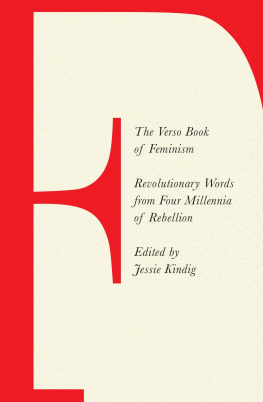First published 2008 by Paradigm Publishers
Published 2016 by Routledge
2 Park Square, Milton Park, Abingdon, Oxon OX14 4RN
711 Third Avenue, New York, NY 10017, USA
Routledge is an imprint of the Taylor & Francis Group, an informa business
Copyright 2008, Taylor & Francis.
All rights reserved. No part of this book may be reprinted or reproduced or utilised in any form or by any electronic, mechanical, or other means, now known or hereafter invented, including photocopying and recording, or in any information storage or retrieval system, without permission in writing from the publishers.
Notice:
Product or corporate names may be trademarks or registered trademarks, and are used only for identification and explanation without intent to infringe.
Library of Congress Cataloging-in-Publication Data
Bernard, Jessie, 19031996.
The Jessie Bernard reader/by Jessie Bernard.
p. cm. (Classics in gender studies)
ISBN: 978-1-59451-482-1 (hardcover : alk. paper)
ISBN: 978-1-59451-483-8 (paperback : alk. paper)
1. WomenUnited StatesSocial conditions. 2. FeminismUnited States. 3. United
StatesSocial conditions. I. Title.
HQ1426.B44 2008
301.092dc22
2008006536
ISBN 13 : 978-1-59451-482-1 (hbk)
ISBN 13 : 978-1-59451-483-8 (pbk)
Designed and Typeset by Straight Creek Bookmakers.
Michael S. Kimmel and Yasemin Besen
I.
In The Feminine Mystique, Betty Friedan issued a clarion call to women who had muffled their ambitions in the gauzy haze of motherhood, suppressed their competences into the drudgery of housework, and channeled their organizational savvy into the strategic requirements of running a neat home, raising competent children, and ensuring that their husbands felt loved. Friedans middle-class white woman plastered a smiley face over her depression, took refuge in cosmetics and cooking, and embraced a feminine mystique; its promise of making her shiny and happy had left her deeply miserable.
Not so Jessie Bernard. Jessie Bernard denied that there was any institutional discrimination against womeneven as she experienced it.
Jessie Bernard was not to the feminist barricades born. She became a feminist through the long and arduous process of theorizing her own experiences and realizing that she wasnt the only one who was feeling the way she felt. As she developed her sociological ideas and turned her sociological gaze inward, back on her own life and circumstances, she understood the now classic connection between biography and history that C. Wright Mills called the defining feature of the sociological imagination.
Bernards indignation was more theoretically derived than personally inspired; her feminism as much analytical as existential. She was both a latecomer to feminism and one of its pioneers: she declared herself a feminist in 1970on the cusp of the second waveat the age of 67.
Although a free-thinking corsetless coed in her youth, Bernard was hardly destined to be a feminist firebrand. She simply wanted to have it alla secure academic career and a loving marriage, a nurturing family and engaging work. Not getting what she wanted radicalized Jessie, as it did tens of thousands of American women in the early 1960s. She gradually linked her personal troubles to public issues, and became in the process a reluctant feminist. And once she did, she was unstoppable.
II.
Bernard was born in Minneapolis in 1903 to a lower-middle-class Jewish family. She experienced marginality early; she wrote that her family was seen as a mere intruder in the neighborhood. She was a liberal and free-thinker, especially around gender issues: as a college student in the early 1920s, she wore her hair short, flirted adventurously, and was eager to experiment with newfound freedoms. She graduated from the University of Minnesota in 1923 with a BA; she earned her MA in sociology and economics in 1925. That same year, against her familys advice, she and her sociology professor, L. L. Bernard, 23 years her senior, were married and moved to St. Louis, where he became a professor at Washington University and Jessie entered the Ph.D. program there. (When they met he was 40 and she was 17.)
In 1935, she received her Ph.D. from Washington University and went to work as a researcher in Washington, D.C. For several years, she worked for the Bureau of Labor Statistics before moving to Lindenwood College (now University) in St. Charles, Missouri, in 1940 as a professor, where she remained until 1947. In 1947 she joined the sociology department at Penn State, where she remained until retiring in 1964.
Although she was only 62 at the time and formally retired, Bernards most productive work dates from her retirement from active teaching. Her major books date from this period, while she was a visiting professor at a wide variety of schoolsfrom UCLA and the University of Delaware to Mills College and American University, where she cotaught a womens studies course with her friend and colleague Muriel Cantor (Cantor, 1988:266).
Her contribution to sociology was the integration of gender; her contribution to feminism was her relentlessly empiricist sociology. A feminism based on anything less than scientifically testable observations of inequality was mere ideology; a social science that ignored the realities of gender inequality was an impoverished sociology. In a sense, she attempted to usher out John Locke and the British empiricist tradition that disaggregated social life into a simple accumulation of discrete individual actions, and to reassert the importance of a Durkheimian paradigm that viewed all individual actions as embedded within and emanating from a social milieu.
Of all her works14 written books, 3 edited books, 5 textbooks, and 123 articles4 works epitomize her contributions to gender studies and sociology. Two of them are more nomethetic works, mapping a terrain that previously had been invisible. The Sex Game (1968) was written before her conversion to feminism. Here Bernard identifies the different strategies men and women employ in understanding each other in relationships. She characterizes mens and womens strategies in negotiating relationships as diametrically opposed to each othera position later criticized for being sexist.
This theme is expanded and elaborated in The Female World (1981). Here she explores the contents of womens sphere and identifies the characteristics of this separate world from men. Bernard celebrates the unique characteristics of women, keeping in mind the differences of race, class, and ethnicity that create variations among women or variations among men. Although this work was often criticized for overemphasizing the differences between women and men, Bernard did something that neither de Beauvoir nor Friedan had done: map the psychological realm that was created through the separation of spheres in a way less critical and more appreciative of womens experience. Whereas other feminists mapped the female world by focusing on what was missing or prohibited (ambition, workplace competence, nonfamilial orientations), Bernard mapped it from an appreciation of womens everyday lives, however normatively constrained they may have been.















